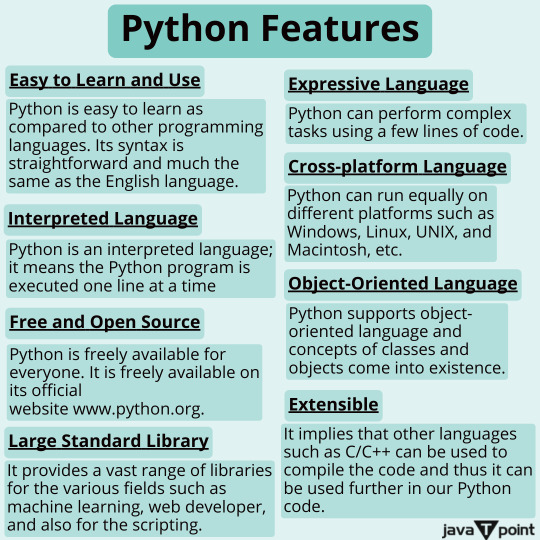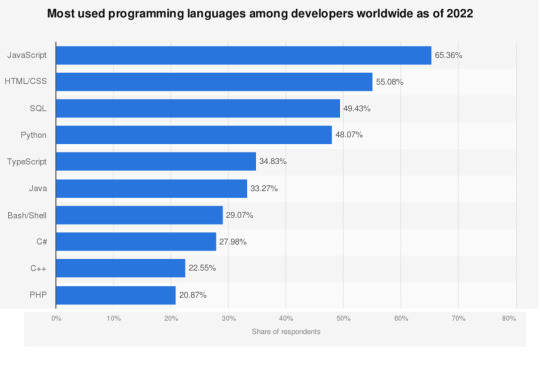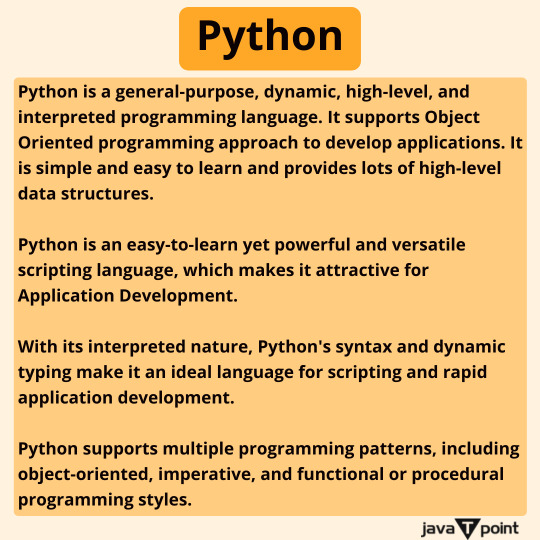#javatpoint
Explore tagged Tumblr posts
Text
Object-Oriented Programming in Java
Hello! Just passing by real quickly.
Here's a Notion page I created a while back during my college Java course, dedicated to the concept of Object-Oriented Programming in Java.
I made it so simple and fun to read , hope it helps someone out there
Happy coding!
#java development company#software#code#javatpoint#developers#codeblr#css#html#javascript#studyblr#progblr#programming#comp sci#web design#web developers#web development#website design#webdev#website#tech#html css#learn to code#resources
60 notes
·
View notes
Text

Python Features . . . . for more information https://bit.ly/3RVzj16 check the above link
#aspdotnet#python#adodotnet#csharp#java#dotnet#dotnetdeveloper#dotnetframework#dotnetclasses#dotnetclasslibrary#computerscience#computerengineering#programming#javatpoint
13 notes
·
View notes
Text
Main Difference between List and Set
Let us see the main difference between List and Set

#java#javatpoint#programming#engineering#code#coding#software#softwaredevelopment#developer#coder#trending#engineer#softwaredeveloper#development#javahashset#hashset#online
2 notes
·
View notes
Text
Making a compiler
Every programmer out there, new or experienced longs for a chance to create their own programming language and compiler. I am no exception. Months ago I decided to fork an old project on github and develop it in my image. The project was a golang-like unfinished compiler, so I dug in and made changes. I changed the language to resemble a subset of rust, go and ocaml. I plan to add a LLVM backend inspired by the tre golang compiler. I will continue working on it until it kinda works. I still have a lot to do. check out the project on the link below. If you want to contribute submit a pull request.
#golang#programming#rustlang#compiler#programming languages#c++#typescript#java#javascript#javaris x#java development company#javatpoint#software#developer#sql#open source#python
11 notes
·
View notes
Text
ECC: Excise Control Code
ECC stands for Excise Control Code. It is a PAN-based 15-digit alphanumeric registration number given to all who are liable to pay excise duty under Central Excise Act.
2 notes
·
View notes
Text
1 note
·
View note
Text
Free Online Coding Tutorials with JavaTpoint: Learn Java and More

JavaTpoint offers free online tutorials for learning programming languages, including Java. It provides a structured learning path with topics ranging from basic concepts like variables and control statements to advanced subjects such as multi-threading, JDBC, and Java Collections. The site includes interactive code examples, allowing users to practice coding and understand how different concepts work in real-time. In addition to Java, JavaTpoint covers other languages like Python, C++, JavaScript, and more, along with web development and database topics. It's a great resource for beginners and advanced learners looking to improve their coding skills without any cost.
0 notes
Text
"Sick of typing out the same number in a loop for exponents in Java? There's a way cooler method (and it doesn't involve steroids). Level up your code with this secret weapon!"
Read More
0 notes
Text
#programming#coding#developer#javafullstackdeveloper#javaprogramming#javatpoint#software engineering
0 notes
Text
HomeFuture of JavaScript
Future of JavaScript in 2023? How can we master in JavaScript?

What is JavaScript ?
JavaScript is one of the most popular programming language in this modern era and has become the foundational part in Website of Web Development. It is basically a scripting language that helps a website Designer (Web Developer) to build interactive website for users. Along with CSS and HTML, the programming language can be used to develop dynamic websites, mobile apps, and even desktop applications. JavaScript language is run on the client side of website or within the browser of the computers.
What is JavaScript used for?
JavaScript for an explanation of how to utilize JavaScript on Wikipedia. Along with HTML and CSS, JavaScript (/ˈdʒɑːvəskrɪpt /), often frequently abbreviated as JS, is a programming language and a fundamental component of the Web. For webpage behavior, JavaScript is used on the client side by 99 percent of websites.

Read more about JavaScript Click on this link:
1 note
·
View note
Text

Python . . . . for more information https://bit.ly/3M18CUZ check the above link
#aspdotnet#python#adodotnet#csharp#java#dotnet#dotnetdeveloper#dotnetframework#dotnetclasses#dotnetclasslibrary#computerscience#computerengineering#programming#javatpoint
8 notes
·
View notes
Text
Coding mastery unlocked: Embrace the power of encapsulation!🧑💻 Join us as we delve into this fundamental OOP concept and discover how it can revolutionize your code structure.🚀💻
#education#interview#technology#coding#student#information technology#developers & startups#programming#software#science#javaprogramming#javatpoint#javajunkie#python#javaris x#javascript#developer#engineering
0 notes
Text
“Any application that can be written in JavaScript, will eventually be written in JavaScript.” - Jeff Atwood
#c++#c++ language#c++ programming#golang#typescript#programming#java#javascript#javatpoint#java development company#software#developer
3 notes
·
View notes
Text
TESTING TOOL (Manual,Java,Selenium).

#business#college#education#student#technology#javascript#java full stack training#javatpoint#javaprogramming#java full stack developer#developer#selenium
0 notes
Text
Navigating the World of Java Training and Placement: A Comprehensive Guide
Java remains a cornerstone programming language, powering a myriad of applications and systems across industries. As businesses increasingly adopt Java-based solutions, the demand for skilled Java developers continues to surge. Consequently, individuals seeking to enter or advance in the field of software development often find themselves drawn to Java training programs.
Java training courses not only equip learners with essential programming skills but also provide avenues for securing lucrative job placements. In this comprehensive guide, we delve into the realm of Java training and placement, exploring the key aspects, benefits, and considerations for aspiring Java developers.

Understanding Java Training
Java training programs encompass a wide range of courses tailored to suit various skill levels, from beginners to experienced developers. These courses typically cover fundamental concepts such as syntax, data types, control flow, object-oriented programming principles, and advanced topics like multi threading, networking, and database connectivity.
Whether offered through traditional classroom settings or online platforms, Java training modules are designed to provide hands-on experience through practical exercises, projects, and assessments. Moreover, many training programs incorporate real-world scenarios and industry-relevant projects to simulate the challenges faced by Java developers in professional settings.
Benefits of Java Training
Versatility: Java's versatility enables developers to create applications ranging from web and mobile apps to enterprise software and embedded systems. By mastering Java through training programs, individuals gain the skills to tackle diverse projects across various domains.
Career Opportunities: Java developers are in high demand across industries, including finance, healthcare, e-commerce, and telecommunications. Completing a Java training program significantly enhances one's employability, opening doors to a multitude of job opportunities with competitive salaries and benefits.
Industry Relevance: Java remains one of the most widely used programming languages globally, with a vast ecosystem of frameworks, libraries, and tools. Training in Java ensures that developers stay relevant in the ever-changing tech industry and are equipped to adapt to new advancements and challenges.
Community Support: The Java community is vibrant and expansive, comprising seasoned professionals, enthusiasts, and experts willing to share knowledge, resources, and best practices. Engaging with the Java community fosters continuous learning and networking opportunities, enriching the training experience.
Choosing the Right Java Training Program
With a plethora of Java training course available, selecting the right program can be daunting. Consider the following factors to make an informed decision:
Curriculum: Evaluate the course curriculum to ensure it covers essential Java concepts comprehensively, including both foundational and advanced topics. Look for programs that offer hands-on projects and assignments to reinforce learning.
Instructor Expertise: Research the credentials and experience of the instructors leading the training program. Experienced instructors with industry expertise can provide valuable insights and mentorship throughout the learning journey.
Learning Format: Determine whether the training program offers flexibility in terms of learning format, such as self-paced online courses, instructor-led classes, or blended learning options. Choose a format that aligns with your learning preferences and schedule.
Reviews and Testimonials: Read reviews and testimonials from past participants to gauge the effectiveness and quality of the training program. Positive feedback from alumni indicates the program's credibility and success in preparing individuals for Java-related roles.
Certification and Accreditation: Consider whether the training program offers certifications or accreditation recognized by industry leaders and employers. A certification from a reputable institution enhances your credibility and marketability as a Java developer.
Placement Assistance and Career Support
Many Java training programs offer placement assistance and career support services to help graduates secure job opportunities post-training. These services may include:
Resume Building: Assistance in crafting a professional resume tailored to highlight your Java skills, projects, and achievements.
Interview Preparation: Guidance and mock interview sessions to prepare you for technical interviews, coding assessments, and behavioral interviews commonly conducted by employers.
Job Placement Services: Access to job boards, recruitment networks, and partnerships with companies seeking Java developers. Some training providers may facilitate direct referrals and job placements based on your skills and preferences.
Alumni Network: Joining an alumni network of fellow Java developers who have completed the training program can provide valuable connections, mentorship, and job referrals throughout your career.
Final Thoughts:
In the competitive landscape of software development, acquiring proficiency in Java through comprehensive training programs is instrumental in securing rewarding career opportunities. By investing in Java training and placement services, individuals can embark on a fulfilling journey towards becoming skilled Java developers, equipped to thrive in the dynamic tech industry.
Whether you're a novice programmer looking to kickstart your career or an experienced developer seeking to upskill and advance, Java training programs offer the knowledge, resources, and support needed to achieve your goals. With dedication, perseverance, and the right training program, you can embark on a successful career path in Java development, making meaningful contributions to the world of technology.
#java online training#javascript#javaprogramming#javatpoint#coding#javatutorial#software#technology#education#it#study blog
0 notes
Text
Online learning code with javatpoint
Tutorials, Free Online Tutorials, Javatpoint provides tutorials and interview questions of all technology like java tutorial, android, java frameworks, javascript, ajax, core java, sql, python, php, c language etc. for beginners and professionals.

1 note
·
View note